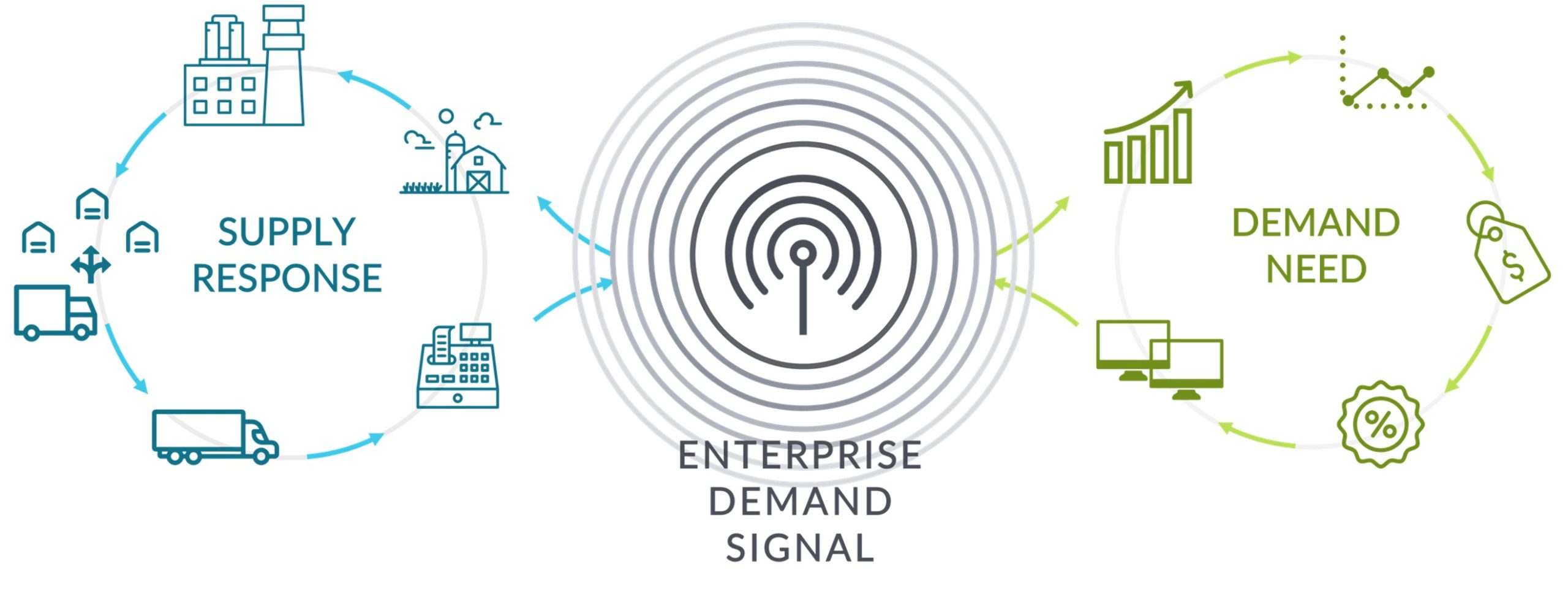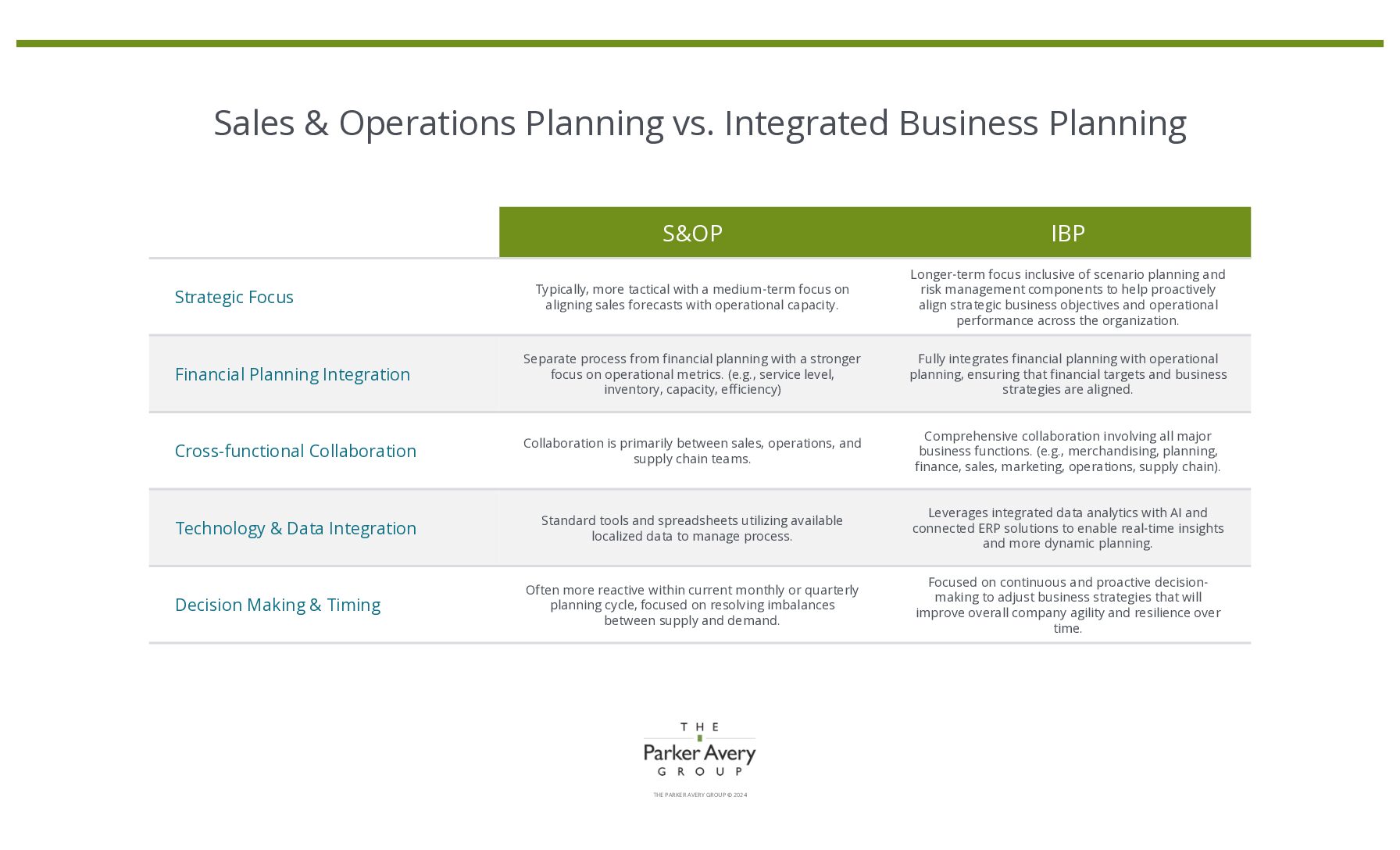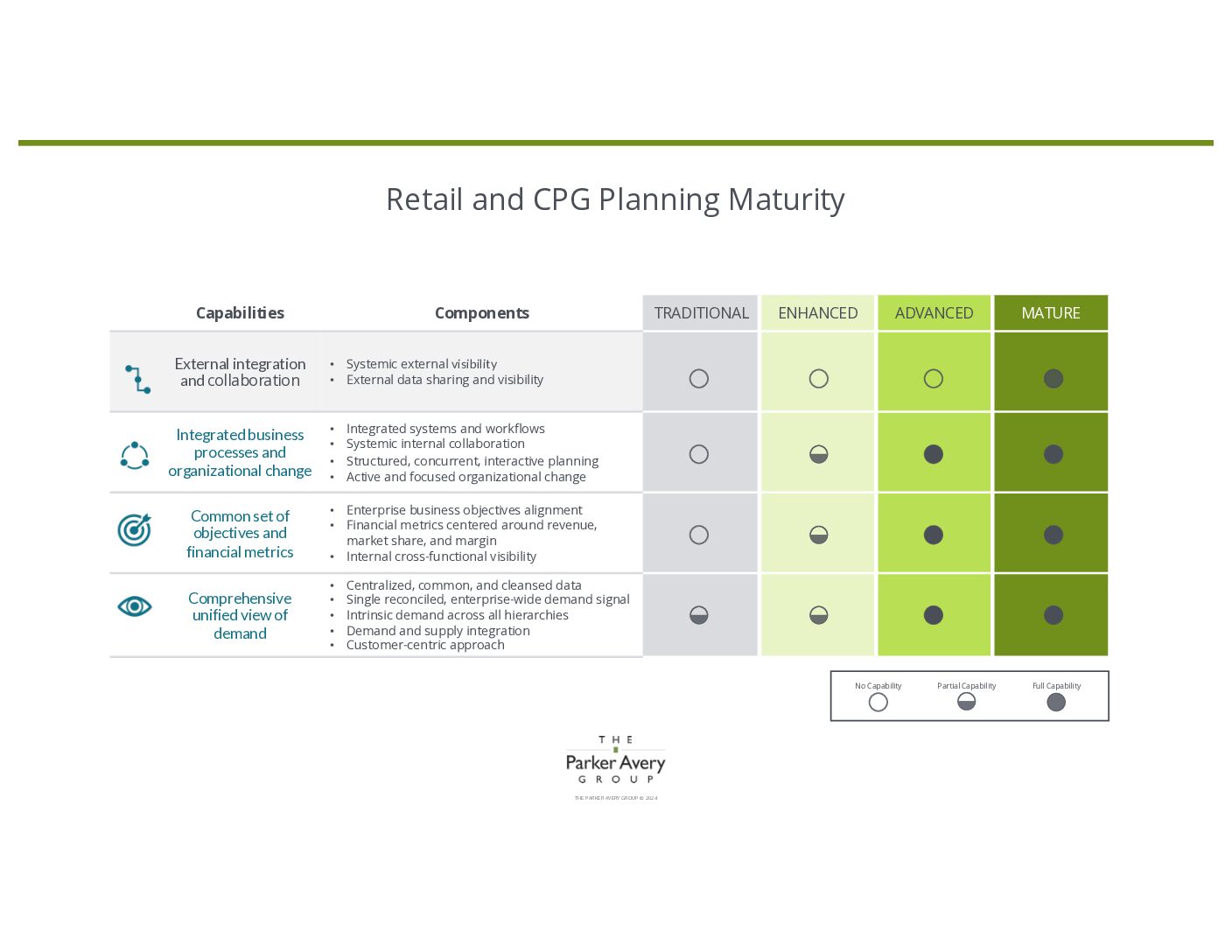The Expert Guide to Integrated Business Planning
Integrated business planning aligns all business functions and initiatives to common objectives.
Integrated business planning, or IBP, is a term that has been used across retail and consumer brands for several decades. However, it has varying definitions and even more varied practical business uses.
In this expert guide, we provide The Parker Avery Group’s definition and unique perspectives on integrated business planning, as well as common mistakes and challenges we see currently across both the retail and CPG industries and during conversations with our clients.
We also explore organizational impacts and innovations that can help enable and improve this strategic capability, including Parker Avery’s Enterprise Intelligence platform and array of consulting services.
What is integrated business planning?
The high-level objective of integrated business planning is to cohesively align all business functions and initiatives to common objectives. IBP drives the alignment of all functions across an organization, primarily through highly collaborative processes that focus on a unified view of demand. With a common view of demand potential, IBP enables the organization to seamlessly align business goals and financial targets with operational execution across all areas of the organization.
The ideal outcome of a well-designed and executed integrated business planning capability is when the demand need is linked with a well-orchestrated and efficient supply response.

It is important to understand that integrated business planning is not a technology. While IBP is typically supported by several different systems, the most effective integrated business planning consists of a series of related and aligned business processes and roles in the organization with the ultimate goal of driving better business outcomes.
Properly performed, integrated business planning is a continuous collaboration between functional areas.
For retailers, these business areas include:
- Strategic planning
- Merchandise financial planning (MFP)
- Assortment planning and item planning
- Retail pricing and promotions
- Allocation and replenishment
- Fulfillment
- Supply chain/logistics
- Store operations
Consumer brand (CPG) areas typically encompass:
- Strategic planning
- Financial planning (LRP and AOP)
- R&D/product development
- Marketing (consumer and trade)
- Materials management
- Manufacturing and DC operations
- Transportation/delivery/in-store support (DSD)
In an ideal scenario, integrated business planning involves both internal and external stakeholders so that the supply response is tightly coordinated and aligned with the demand need. In this light, retailers and their consumer brand partners collaborate to proactively respond to demand signals.
How is IBP different from traditional S&OP?
Integrated business planning represents an expansion of sales and operations planning (S&OP) but focuses on connecting a company’s strategy and business plan for better decision-making across all functional areas. S&OP is traditionally performed monthly and is very serial. However, IBP is a continuous, iterative process that relies on a singular, updated view of demand to enable each functional area of the enterprise to quickly identify challenges and opportunities, seamlessly collaborate to solve problems, and continually adjust plans as circumstances change.

What capabilities are necessary for successful integrated business planning?
In this section, we delve into the core capabilities that form the foundation of effective IBP. We’ll explore three key tenets that organizations must address to successfully implement and maintain a robust IBP environment.
First, we’ll examine the components necessary for developing a comprehensive unified view of demand, which relies on centralized data management and holistic forecasting approaches. Next, we’ll discuss the significance of establishing common objectives and financial metrics across the organization to ensure aligned decision-making. Finally, we’ll explore components of functionally integrated business processes and organizational change management to support and sustain IBP initiatives.
Three Key Tenets to Successful IBP
Comprehensive Unified View of Demand
Effective integrated business planning is built on a comprehensive unified view of demand, encompassing centralized data management and a holistic approach to demand forecasting.
Key components include:
Centralized, Common Data (Prerequisite)
- Establish a central data repository accessible to all stakeholders
- Implement robust data governance practices to ensure accuracy, consistency, and timeliness
- Maintain data integrity and reliability to enable confident, data-driven decision-making
Single, Consistent Enterprise-Wide Demand Signal
- Utilize a single, consistent demand signal across all business functions
- Enable demand disaggregation and aggregation across products, channels, locations, and time factor
Intrinsic Demand Across All Hierarchies
- Disaggregate demand to understand driving factors from multiple perspectives
- Optimize inventory, production, and service levels using sophisticated planning systems
- Conduct ongoing supply chain assessments, considering raw materials, supplier capabilities, and distribution capacities
- Balance demand and supply to improve overall supply chain decisions
Customer-Centric Approach
- Align offerings with customer needs and preferences
- Leverage marketing, pricing, and promotional factors to shape demand
- Simulate internal and external demand drivers
This comprehensive approach allows organizations to balance customer satisfaction with operational efficiency. By integrating demand and supply data while maintaining a customer-centric focus, companies can respond more effectively to market changes and optimize their entire value chain. The flexibility provided by this unified view supports various planning needs across the organization, from strategic to operational levels.
This foundation is crucial for successful IBP implementation, allowing companies to adapt quickly to market dynamics and maintain a competitive edge.
Common Set of Objectives and Financial Metrics
Successful IBP also relies on a shared understanding of goals and performance measures across the organization. This alignment ensures cohesive decision-making and agile responses to market changes.
Key components include:
Performance Management and Metrics
- Establish a common set of key performance indicators (KPIs) and metrics
- Monitor performance across business functions
- Tie together common decisions across various departments
Enterprise Business Objectives Alignment
- Ensure business plans align with the company’s strategic goals and objectives
- Adapt to changes in demand, bridging the gap between strategic planning and operational execution
- Maintain continuous dialogue between executives and functional leaders
- Assess constraints and risks across the company, focusing on capacity, people, and process impacts
Internal Cross-Functional Visibility
- Provide access to relevant KPIs and metrics across all functional areas
- Implement dashboards and reporting tools offering a holistic view of the business
- Ensure visibility into constraints, risks, and impacts across the enterprise
This approach fosters a unified organizational perspective, allowing companies to respond effectively to market dynamics, optimize resource allocation, and maintain strategic focus while adapting to operational realities. By aligning objectives, metrics, and visibility across functions, businesses can enhance their agility and performance in a rapidly changing environment.
Functionally Integrated Business Process and Organizational Change
Successful IBP combines integrated systems and processes, cross-functional collaboration, and technology and data integration to create a cohesive framework that enhances decision-making and organizational performance. By aligning financial and operational planning, fostering collaboration across departments, and ensuring the business adopts and sustains new ways of working together, companies can proactively anticipate market changes, reduce inefficiencies, and drive sustainable growth.
Key components of this capability include:
Integrated Systems and Workflows
- Integration systems across planning, execution, and analysis
- Develop automated workflows connecting different stages of the planning process to reduce errors and improve efficiency
- Leverage advanced technologies like AI and machine learning to enhance planning capabilities and decision-making processes
Systemic Internal Collaboration
- Integrate financial planning with operational planning to align financial targets and in-season forecasts
- Foster collaboration and communication across finance, operations, merchandising, supply chain, and marketing
- Break down departmental silos to ensure all functions have connected data and work towards common goals
- Establish cross-functional teams for integrated planning and decision-making to enhance organizational performance
Structured, Concurrent, Interactive Planning
- Implement a formalized, cyclical planning process involving all relevant stakeholders
- Enable simultaneous planning across different time horizons and functional areas
- Use scenario planning and what-if analysis tools to support interactive decision-making and prepare for various market conditions
- Adapt to changes by considering the financial and operational implications of demand fluctuations, enabling proactive adjustments in open-to-buy and store operations
Active and Focused Organizational Change
- Drive organizational change initiatives to ensure smooth transitions and adaptation to new processes, as well as sustainment of new ways of working
- Monitor and evaluate the impact of changes to refine strategies and achieve desired business outcomes
- Engage leadership and stakeholders in change efforts to promote a culture of continuous improvement
What does a mature integrated business planning environment look like?
We believe the three tenets described in the prior section are critical to IBP success. The companies most mature in their IBP environment also tightly weave external partners into the process through systemic integration, data visibility, and collaboration.

It is important to recognize that most companies exhibit some of these capabilities at least partially and fall somewhere between the traditional and enhanced stages. We have seen only a handful of retailers and consumer brands that would be considered advanced or mature in their planning capabilities.
What common mistakes or challenges exist?
Even with some of the best business processes in place, one of the biggest challenges with traditional planning is that decisions are highly siloed across most companies’ functional areas. One part of the organization makes decisions for the areas in which they have accountability and responsibility. However, those decisions may negatively impact upstream and downstream functions. There is often a lack of visibility to constraints across these functional silos, which can negatively (but unintentionally) impact outcomes.
Traditional planning involves each area producing a demand forecast in their systems or spreadsheets, and lately, separate advanced analytics applications. Even if all areas start with a common view of demand, and as accurate as some of these forecasts may be, the problem is that different functional areas often end up with disparate demand plans. The plans are modified in finance, supply chain, merchandising, and other functions in their relevant planning metrics, and the mitigated signals do not flow back through the organization. This is one of the leading sources of cross-functional misalignment leading to lost productivity, inventory imbalances, and reduced margins.
What innovations can improve a company’s integrated business planning capabilities?
Particularly with the advancement of AI, we are seeing cutting-edge developments in business planning, product development, and supply chain management. However, the key to integrated business planning success lies not just in adopting new technologies, but in fundamentally aligning leadership and refining core processes. Let’s explore this tenet along with innovations that can enable better planning capabilities.
As mentioned earlier, ensuring leadership alignment with embracing a more collaborative approach to planning is a critical first step. As with any transformation, leadership alignment must be supported by a well-executed organizational change and communications plan to engage stakeholders and influencers and mitigate any criticism or apprehension.
Closely related to leadership alignment is redesigning the company’s planning processes to introduce or deepen the collaborative mindset as well as incorporate any technological changes.
One of the most impactful innovations that drives the capabilities outlined earlier is a modern, flexible, demand analytics platform that:
- Provides a single, real-time projection of demand
- Translates the common demand signal across a broad range of interconnected KPIs, enabling enterprise visibility to cross-functional constraints
- Is instantly updated across metrics, hierarchies, and time dimensions
- Incorporates internal and external data sources
- Utilizes advanced analytics and AI for scenario planning and predictive insights
- Supports AI-driven optimization of product assortment, pricing/promotions, inventory, and supply chain operations
- Enables user-friendly visualizations and dashboards
There are some demand forecasting and planning technologies in the market that claim to provide some of the above elements. However, Parker Avery’s Enterprise Intelligence platform delivers all of these with best-of-breed accuracy and seamless integration with our clients’ systems. Our total solution provides an efficient and collaborative supply response to a unified demand signal that uses the most advanced analytics available today.
The integration of AI in product creation has revolutionized how companies design and bring new products to market. AI algorithms can analyze vast amounts of data to predict trends, consumer preferences, and potential product performance, significantly reducing time-to-market and increasing the likelihood of product success.
Modern PLM systems now incorporate visual boards that provide intuitive, graphical representations of the product development process. These boards enhance collaboration by allowing team members to visualize and track the status of various product components, from ideation to production, in real time.
Blockchain technology is being increasingly adopted to enhance supply chain transparency and traceability. By providing a secure and immutable record of transactions, blockchain helps ensure the authenticity of products, reduces fraud, and improves overall supply chain efficiency.
The Internet of Things (IoT) has enabled smarter inventory management systems that provide real-time visibility into inventory levels, movement, and condition. IoT sensors can track products throughout the supply chain, helping companies optimize inventory levels, reduce waste, and improve order fulfillment accuracy.
Final Word
Integrated business planning represents a crucial evolution in retailers’ and consumer brand companies’ strategies, moving beyond traditional sales and operations planning to create a more cohesive, responsive, and efficient business model. The key to successful IBP lies in three main areas: establishing a comprehensive unified view of demand, aligning around a common set of objectives and financial metrics, and implementing functionally integrated business processes supported by change management. While technological innovations like AI-driven product development, blockchain for supply chain transparency, and IoT-enabled inventory management can significantly enhance IBP capabilities, the foundation of success remains rooted in leadership alignment and well-designed business processes. By embracing these principles and leveraging advanced analytics platforms like Parker Avery’s Enterprise Intelligence, companies can break down silos, improve cross-functional collaboration, and make more informed decisions that drive sustainable growth and competitive advantage.
If you would like to learn more about how to improve or enhance your integrated business planning capabilities with Parker Avery’s comprehensive approach and demand analytics platform, we would love to start a conversation.
Contributors
The Parker Avery Group transforms retail and consumer brand challenges into measurable, sustainable improvements.
You may also like







